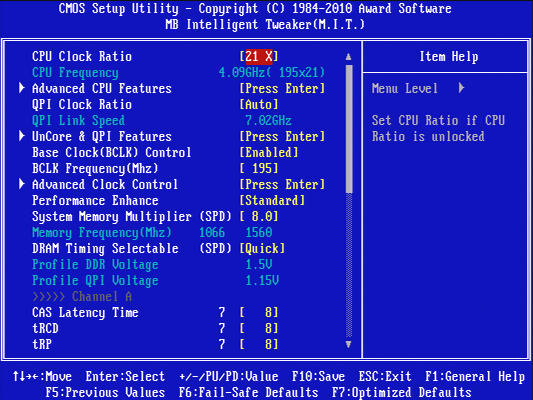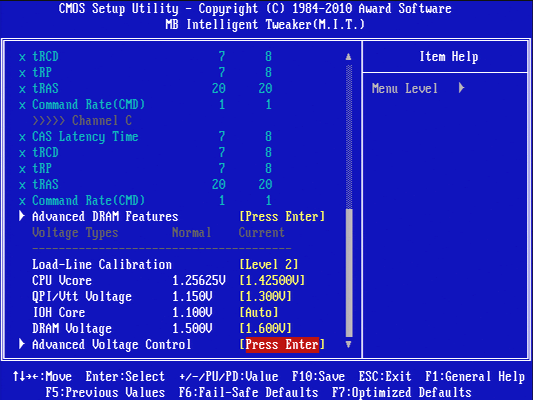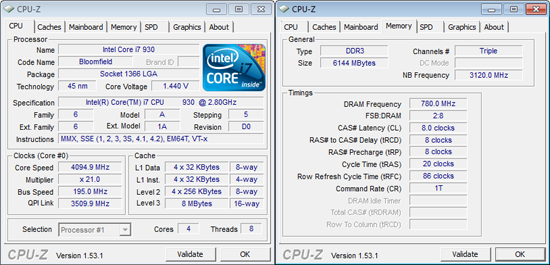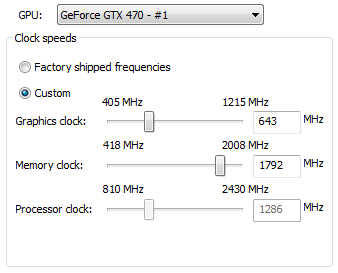System Builder Marathon, June 2010: $2,000 Performance PC
Overclocking
The most common problem we’ve had with long-term overclocking on Intel’s 45 nm process isn’t dead parts, but damaged parts that still appear to function correctly when set to far lower speeds. Intel wasn’t joking when it told us two years ago that 1.45V was the absolute limit for then-current parts, as we’ve seen everything from Core 2 to Core i7 devices damaged over a period of a few weeks using only a few hundredths of a volt more.
The bad news is that our current Core i7-930 wouldn’t exceed 4.1 GHz at anything less than 1.45V, even though our previous SBM machine ran at 4.3 GHz using only 1.36V with a lower-model processor of the same core revision. Receiving a highly overclockable processor usually happens by chance, and this time we were not so lucky.
The good news is that heat was never a problem. Most of our Nehalem-based processors will run with stability right up to the point at which they reset (between 100 degrees and 101 degrees Celsius), and ours didn’t get anywhere near that level before it simply ran out of overclocking capability. Using a faster fan that dropped the CPU core temperature by five degrees Celsius offered no improvement in its overclocking headroom. Higher voltage helped, but when we saw the core voltage fluctuate above 1.45V, we decided to back off for the sake of longevity.
Next, we added Nvidia Control Panel software, which enables the overclocking tab in its driver controls. Starting at a lowly 607 MHz GPU and GDDR5-3482, these cards were initially stable at an incredible 701 MHz GPU and GDDR5-3896. After an hour or more, the cards became unstable, a problem resolved by dropping the graphics memory clock. Another 30 minutes passed before our new overclock became unstable, a problem resolved by dropping the GPU clock. This type of progressive instability continued until we finally got through a complete benchmark set and stability test at 643 MHz GPU, GDDR5-3584.
Whether the overclocking capabilities of these cards continues to decline is a question only fate can answer, since we ran out of time after two days of additional tests. Full-load temperatures were held constant throughout all test conditions with the GeForce GTX 470 automatic fan controls and we never reached the cooling limits of either card at any frequencies.
Get Tom's Hardware's best news and in-depth reviews, straight to your inbox.
-
gkay09 ^ Very good selection of parts IMO...Reply
It still has a room for a SSD -> OCZ Vertex 2/ Agility 2 50GB or Vertex/ Agility 60GB...these both retail under $200... -
Aatish That's just sad! in 3 months your 2000$-3000$ investments depreciated at awful rate! and usually when an average customer builds a PC he at-least don't expect to repeat the process with-in few months.Reply
But, a good rig!for someone who is just about to build his new PC with that much budget! -
frye Maybe you guys should give away a $10,000 PC in September ;)Reply
Oh, and are those temps right? Nearly 93 C CPU temp when overclocked? I'd scale that back a bit... -
TomD_1 I wanted to enter the competition... but I live on the other side of the world :(Reply
Great build though, might have put a bit more money towards the case if I was building it -
Flamango I love SBMs, and the fact that I haven't built my p55 setup yet, and I'm sure the Megahalems will look great in my new case. Can't wait for the cheaper builds!Reply -
Relayer Need a bigger PSU. Why are you using the one you did? You have the funds to buy one that will drive this system properly.Reply -
a4mula Can't say I agree with much here. You pick up a budget case that's going to restrict airflow due to lack of wire management, and then drop 75 on a cooler. Megahalems are spectacular, I own one myself but you've defeated any gain by placing it in a subpar enclosure. Should have just went with a 902 and a CM 212+. Would have been cheaper and less restrictive.Reply
I still fail to see the love of 1366 in these builds where there is no intention of upgrading to hexacore. Save the $100 and do a p55 i7-860 build. You're going to get performance that rivals the 930 on every benchmark including those that take x8/x8 into consideration. You'll surpass the 930 in a few.
700 for dual 470s when you can get dual 5850s for 560.
PSU that is being heavily overtaxed. You're risking the entire 2k machine by running 100w over the psus rated value. The only thing keeping this machine running is the fact that Silverstone makes high quality parts and you have a single rail. Had this of been a multi-rail you would have been pulling out a gpu, scaling back your overclocks, or buying a new psu. At some point you have to wonder if this is a safety hazard.
Sorry Thomas, just not feeling this build at all. I see about $400 of budget that could have easily have been trimmed and would have been within a few percentage points of the current build. This could have gone towards anything from your much wanted redundant storage to SSD drives. -
madass $50 cases with side opened>hiogh end case with side closed.Reply
And no, I've never had problems with dust. And I own a dog. Go figure. -
madass IMO they should have taken an i5 750 (USD80 saved) and 4GB of CL7 1066-no game out there uses more than 2GB, more than 4GB is a waste(at least another USD40 saved). P55 mobo with 2x x8= USD 120. 80 saved. Total: USD200. Dual 5870's anyone? Don't forget- the 5970 has a lot of problems with CFire scaling- even a pair of 5850's can beat it in most cases, especially at 2560-blame crappy ATI drivers.......Reply -
Crashman RelayerNeed a bigger PSU. Why are you using the one you did? You have the funds to buy one that will drive this system properly.Nobody thought it would draw more than 750W peak load. Even so, the article has been revised to show that the actual power output was only 660W to 680W, well below the unit's limits.Reply
a4mulaCan't say I agree with much here. You pick up a budget case that's going to restrict airflow due to lack of wire management, and then drop 75 on a cooler. Megahalems are spectacular, I own one myself but you've defeated any gain by placing it in a subpar enclosure. Should have just went with a 902 and a CM 212+. Would have been cheaper and less restrictive.I still fail to see the love of 1366 in these builds where there is no intention of upgrading to hexacore. Save the $100 and do a p55 i7-860 build. You're going to get performance that rivals the 930 on every benchmark including those that take x8/x8 into consideration. You'll surpass the 930 in a few.I'm not seeing the point of the Blueray drive. If this was a bare bones value to performance build it sticks out like a sore thumb. 700 for dual 470s when you can get dual 5850s for 560. Sorry Thomas, just not feeling this build at all. I see about $400 of budget that could have easily have been trimmed and would have been within a few percentage points of the current build. This could have gone towards anything from your much wanted redundant storage to SSD drives.It's OK a4mula, but you're completely wrong.
1.) The air temperature in the case was excellent. Tom's has tested enough cases to know that smaller models that fit tightly around the CPU cooler do an excellent job of cooling the CPU area, so long as the rear fan is fast enough.
2.) Tom's tested the 212+, and it's only fair (not great). This months build was expected to reach high overclocks.
3.) Tom's has also done an i7-860 build around six months ago, that CPU was one of the worst-overclocking i7's Tom's has ever used. Subtract around 4-8% in game performance for using x8 slots, and the value evaporates.
4.) Would you build a $1000 machine that can't run DVD's? Then why would you build a $2000 machine that can't play BRD's? BRD's are close enough to mainstream that not having the capability should be the thing that "sticks out" IMO, but you do make a decent argument since this pick was based on an opinion.
5.) Yeh, you saw how dual 470's smashed the performance of dual 5870's? Oh, that was a 5970...well there you go. 470's take the big win.
So a4mula, points 1-3 and 5 are purely factual and based on testing. You might be able to win the opinion-based argument on #4, but whoever gave you the thumbs-up was also wrong so don't let popularity mislead you.





